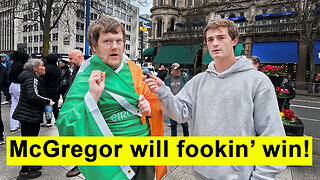Premium Only Content

How to play Hues and Cues
Learn the rules to the board game Hues and Cues quickly and concisely - This video has no distractions, just the rules.
Don't own the game? Buy it here:
amazon.com - https://amzn.to/3SSeFg8
amazon.ca - https://amzn.to/3ChinIX
amazon.uk - https://amzn.to/3ymlzC4
amazon.de - https://amzn.to/3REh78s
amazon.it - https://amzn.to/3CHcAOg
amazon.nl - https://amzn.to/3CGZC33
(As an Amazon Affiliate, I earn from qualifying purchases)
RULES:
The object of the game is to score the most points. Lay out the board and give each player 3 pieces of the same color. Players place one of their pieces to the left of the score track. Shuffle the color cards to form a face-down draw pile. Set the scoring frame to the side. The player wearing the most colorful outfit is the cue giver first, then the role rotates clockwise each round.
On your turn as the cue giver, draw 1 card from the top of the deck and secretly look at it. Pick one color on the card then tell all the other players a one-word cue that will help them guess the color you picked. The cue may be any single word except:
• It may not be a color name from this list: purple, blue, green, red, pink, yellow, orange, brown, white, black, gray. Abstract colors like “lavender” or “seafoam” are acceptable.
• You may not refer to the color’s position on the board, or the letters, or numbers.
• You may not refer to any object in the room.
• You may not repeat a clue already used earlier in the game.
Now, starting with the player to your left and proceeding clockwise, all the other players must make a guess to what your color is by placing one of their pieces on any empty color square on the board. Players may not guess a color that already has a piece on it and pieces may not be moved. Once all the other players have placed their first piece, then you may give a two-word cue. The two words must follow the same guidelines as before. This includes not using words like “lighter” or “darker” to suggest a position on the board relative to the first guesses made.
Now, this time, in counterclockwise order from you, every other player makes a second guess with their piece on any unoccupied space on the board. Once all the other players have guessed, you then reveal your color and place the scoring frame centered around that space. Use the letter and number grid to properly align it. You, as the cue giver, receive 1 point for every player piece that is located within the scoring frame. In a 3-player game, receive 2 points per piece instead.
All the other players receive points based on each of their piece’s proximity to the correct color. An exact guess of the correct color is worth 3 points. A guess that is off by one space in any direction is worth 2 points. A guess off by 2 spaces is worth 1 point and all other guesses are worth 0 points. Use the scoring frame to help you calculate points quickly. Players advance their pieces along the scoring track the appropriate number of spaces.
The cue giver is allowed to pass on giving the second two-word cue if they want. If that happens, then all the other players do not place down their 2nd pieces, but instead, scoring happens immediately.
After scoring, all guessing pieces are removed from the board and the role of cue giver rotates clockwise by one and a new round is played. In a 3 to 6 player game, the game continues until each player has been the cue giver twice, or, in a 7 or more player game, each player is the cue giver once. Then the game ends and the player with the most points wins. In the event of a tie, play tie breaker rounds until you get a winner.
-
![I'm Grand (Master) [Official Music Video] - Triple S Games & Sheet Music Boss](https://1a-1791.com/video/s8/1/9/v/q/d/9vqdo.0kob-small-Im-Grand-Master-Official-Mu.jpg) 3:36
3:36
Triple S Games
1 year ago $0.07 earnedI'm Grand (Master) [Official Music Video] - Triple S Games & Sheet Music Boss
1.81K5 -
 31:34
31:34
Friday Beers
9 hours ago $1.29 earnedWe Drank 12 Beers and Solved the Case of 9 Dead Hikers
16.7K2 -
 18:11
18:11
Nick Shirley
4 hours ago $1.08 earnedAsking The Irish If They Will Vote for Conor McGregor 🇮🇪
21K35 -
 LIVE
LIVE
Illyes Jr Gaming
5 hours agoIt's Wednesday! Let's Hit 300 Followers TONIGHT!
191 watching -
 LIVE
LIVE
Joker Effect
2 hours agoIs our government safe?***Streamer News***DRAMA***RUMBLE GETTING LEVERAGE***GAMING
702 watching -
 14:55
14:55
T-SPLY
7 hours agoDemocrats Accused Of Not Calling Out Joe Bidens Security Disasters
19.4K8 -
 LIVE
LIVE
ZachTheRipper
2 hours agoWe Back With A Passion - 0/20 Subs - Interactive Streamer - #RumbleGaming
178 watching -
 16:19
16:19
Tundra Tactical
6 hours ago $0.08 earnedGEN Z Brit 3D Prints a WORKING Gun!
18K8 -
 48:01
48:01
Man in America
10 hours agoWHEN WILL THE ARRESTS BEGIN?! w/ General Michael Flynn
25.6K22 -
 LIVE
LIVE
BSparksGaming
2 hours agoNear the End? Assassin's Creed Shadows Campaign
101 watching